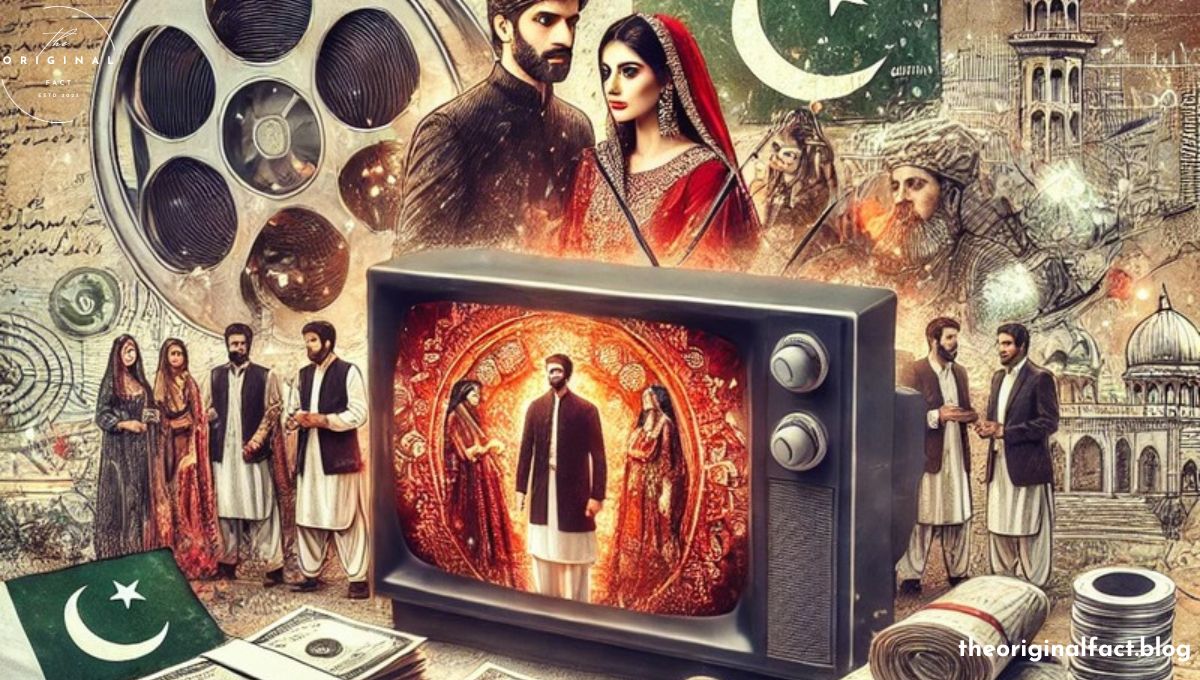Table of Contents
Business Model of Pakistan Drama Industry Case Study
Introduction: Cultural Relevance of the Pakistani Drama Industry
Pakistani drama is considered within the cultural scenario of the country. With its detailed plot, highly empathetic characters, and themes engaged with society at all levels, it successfully managed to win not only the highest viewership nationally but also internationally. From its golden years of PTV classics such as Dhoop Kinare to present-day hits including Mere Paas Tum Ho and Humsafar, the dynamics have grossly changed. Behind this normative cultural phenomenon lies a business model. That is what one has to understand in case one wants to know how Pakistani dramas are produced, distributed, and monetized.

The blog would focus on the little mechanisms of the Pakistani drama industry: how its revenue streams come about, how dramas are produced, and what challenges the distribution channels face. By researching these elements, we aim to give our readers an insight into the business model of one of the most favored entertainment industries in Pakistan.[1]
1. Where Revenue Streams Gush: The Lifeblood of Business
This will help much in keeping the financial backbone of the Pakistani drama industry with its many revenue streams and will be beneficial in keeping its profitability and sustainability.[2]
1. Advertising Revenue:
Advertising forms the chief revenue stream for the television networks that air Pakistani dramas. Brands spend a hefty amount on running their commercials during drama serial slots that reach millions of viewers across the globe. The sheer volume of viewership during the prime time slot, typically reserved for drama serials, brings in value for the advertising spots.

Product placements within dramas are another form of advertising revenue. Many a time, brands contact production houses to have their products included in the drama storyline, also discreetly interweaving them into the narrative.
2. Sponsorship Deals:
Or even cases of the major brands sponsoring entire drama serials, where the brand image is associated with the themes or with the stars of the serial. In return, its prominence with title sponsorships, exclusive ads, and promotional campaigns associated with the drama.
3. International sales and syndication:
There are excellent viewerships of Pakistani drama serials throughout South Asia, the Middle East, and the Diaspora in the US and Europe. Normally, the broadcasting rights for the dramas are purchased from production houses and networks to foreign channels, and a huge amount of money is involved.
Streaming Over the internet is yet another significant source of revenue. These companies use their services leveraging either advertising, subscription fees, or both to make money.
4. Digital Monetization:
sphragistics With the rise of digital platforms, many drama producers now release content on digital platforms like their own YouTube channels or through collaborations with OTT platforms for mutual benefits and interests. Ad revenue subscription pay-per-view and other monetization through these allowable platforms.

The diversity of revenue lines ensures the business remains financially self-sustaining, despite changes in viewing habits and media use.
2. Production Process: Balancing Creativity and Budget
Pakistani drama-making is, thus, a creative exercise interspersed with a budgetary one. The whole process may broadly be divided into phases:
1. Concept Development:
Concept development is where writers and producers connect with audience members to throw ideas that make some sense to them. This is usually done after thorough research on current social issues, audience preferences, and cultural trends so that the drama remains relevant and interesting to its followers.

2. Scriptwriting:
o Once the idea has been finalized, scripting follows. Scriptwriting involves writers collaborating with directors and producers to produce scripts that align with the drama vision while being feasible within the available budget. More often than not, there are serial scripts, and every episode is written at some part of the production process.

3. Casting and Pre-production:
Casting forms a serious part of the production process because the success of a drama relies heavily on the popularity and performance of the actor. Production houses pick out their actors by considering their drawing ability, and many times, known faces are picked up just to guarantee the success of the drama.

Location scouting, site setting, and costume designing in pre-production require very careful budgeting.
4. Shooting and Post-production:
The shooting is fast-paced because generally there are budget constraints. Even the episodes are completed back to back to keep the budget as minimal as possible; within their budget, the scenes should be bright and captivating for the viewers.

Post-production involves editing, sound design, and adding special effects. This is a very important stage in ensuring the quality and drama’s final appeal.
5. Marketing and Advertising:
Before airing, dramas undergo extensive marketing campaigns. Trailers, promotional songs, and star interviews are used to generate buzz and attract viewers.
That is a very hard job, but rewarding, provided the whole production process stays in balance between creativity, audiences’ expectations, and financial considerations.
3. Channels of Distribution: Reaching the Audience
The Pakistani drama distribution has immensely adjusted to the changing face of technology, understanding changes in consumers and what will possibly reach them best. Today, dramas reach their audience through all these channels:
1. Television Networks:
The dominant distribution platform for most Pakistani dramas remains traditional television. Key networks among these include Hum TV, Geo Entertainment, and ARY Digital. They mainly dominate the market due to the battle of each channel to secure the maximum rating during prime time. Networks created a following, and it became the most vital platform for drama releases.

2. Online Streamlining Platforms
New delivery channels have placed Pakistani drama serials on the internet and are now available through YouTube, Netflix, and other OTT services in the area, dramatically making the same popular among young and global audiences. Convenience to view it on demand: The feature allows viewers to take their preference of drama serials anytime and anywhere.

Online sites also offer dramatizations in high definition, including some with subtitles. This makes it easy for the non-Urdu audience to follow.
3. International Broadcasting:
The dramas are also exported overseas via satellite television channels and internet services. The outright regional countries for example India, UAE, UK also have sets that regularly telecast Pakistani content. Above and beyond the viewership growth the foreign exports are an extra source of revenue through the foreign syndication agreements.
4. Issues
While the Pakistani drama industry has gained widespread success, many factors may cause a downfall in growth in the future:
1. Budget Constraints:
The budgets of many production houses are pretty tight, which reduces the scope for quality production and related creativity. High-quality productions require deep pockets, which are not always available especially not in the case of smaller production companies.
2. Competition and Content Saturation:
It resulted from numerous drama productions that it is saturated content, and new productions can hardly impress. The audience is spoiled of choice thus maintaining high ratings with viewers’ attention has been a herculean task.
3. Piracy:
Online movie piracy is still a perennial bane for the industry. This unauthorized proliferation of dramas through illegal websites and social media platforms eats into revenue flows and more specifically that from digital releases.
4. Cultural and Social challenges:
The industry often deals with censorship and societal pressures, particularly when confronting sensitive or controversial issues. Always, cultural norms and artistic values are in a point of balance between challenges.
5. Opportunities
The industry, despite these challenges, also has several opportunities:
1. Proliferation of online platforms:
Digital formats have large streams of revenue and can possibly reach a global market. This means that they have resources in collaborative programs with Netflix, and Amazon Prime for global streaming services.
2. Versatile Content
The demand for diversified and innovative content is growing. This brings in enormous opportunities for the producers to take creative risks while keeping the cultural reality in mind for engaging huge audiences and earning big bucks.
3. Universal Applause
Many Pakistani dramas have won several international awards. That gives them a certain international recognition, which can be turned into further business with investment and collaborations by production houses abroad.
Conclusion Future of Drama Industry in Pakistan
The Pakistan drama industry is a bright one at the crossroads, with formidable challenges and bright opportunities set on the horizon. Having its business model sitting on a mix of diversified revenue streams, strategic production processes, and dynamic distribution channels at any one point in time, it has been able to position itself hierarchically in a competitive ecosystem of entertainment. The sustainability of the industry will have to battle budget constraints, combat piracy, and continue innovating in content.
There is quite some potential for growth in digital platforms with rising global recognition. Riding this crest, the industry will be able to secure not only its roots but also its place in the international platform. The future of the Pakistani drama industry now depends upon how effectively it adapts to new technologies, audience likings, and trends around the world since all of this makes up a vital and dynamic part of the cultural identity of Pakistan.
To Read More: Click Here

